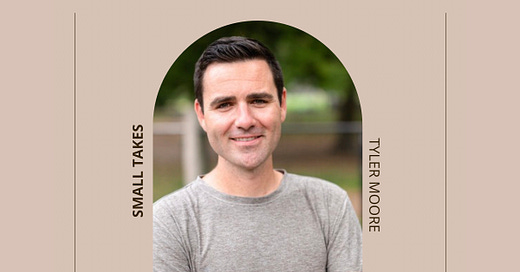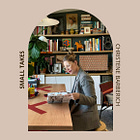Small Takes with Tyler Moore, the Tidy Dad
How a family of five makes their 750-square-foot New York City apartment work.
Wishing everyone a Happy May Day (aka International Workers Day).
In Small Takes, I ask people who are living small how they make it work. When I asked Tyler Moore, a public school teacher who moonlights as the
(@tidydad), if he would answer my questionnaire, I had no idea we were practically neighbors. He and his wife Emily and their three daughters live right near me in Queens. I was also surprised to learn that we had similar experiences with real estate.Back in 2019, Tyler and Emily were living in their current 750-square-foot railroad-style apartment with two daughters and looking to buy an apartment when they realized the math on the purchase wasn’t in their favor. Buying would eat up all their savings and cost them a lot more every month. So, they pivoted and purchased an 1,100 square-foot summer cottage in Pennsylvania. In the city, they stayed put in their tiny apartment—even after their third daughter was born. (Priced out of Brooklyn twelve years ago, my husband and I also bought property outside of the city before we purchased our current apartment.)
Tyler and his wife are naturally neat, but getting intentional with their tidying and organization systems is what has helped them continue to live small with three kids. (Tyler shares all his tips in his book Tidy Up Your Life and his newsletter The Tidy Times.) Yes, having a summer escape hatch helps, but Tyler notes that during the school year they are not at home for much more than dinner, sleep, and breakfast because they’re out enjoying the city. Their motivation to live small was financial, but they’ve stuck with it because it’s brought them joy. Tyler told me, “Small space living enhances our family's life. We have opportunities to do things that we wouldn't otherwise. It enhances the way in which we interact with our city and our community. So, we're willing to put in the work that it takes to maintain our small space.” A sentiment I could not agree with more.
Here’s how Tyler makes his small space work:
What is your definition of living small?
We’ve chosen to live below our means—and below the square footage society says you need to be happy. We have a clear definition of what is just enough so we can make space for what really matters: time together, fewer distractions, and the freedom to focus on joy over stuff.
What has living small given you?
Living small has given our family life. It opened up how we spend our time. We get out more. We explore the city. We travel the world. It’s helped us see what’s possible.
When we set a boundary on how much space we needed in New York, it gave us room to dream. And in 2019, that dream took shape as a tiny cottage in Pennsylvania—a place that’s become our second home, and a big part of our story. During the school year, we rent it out as a short-term rental. But once school’s out? We’re there full-time for the summer.
What is the real reason you live small?
There’s a quiet kind of simplicity to small space living. It might sound strange to outsiders, but life in New York City feels incredibly simple. My daughters and I all go to the same school, just six blocks from our apartment. The grocery store? Right around the corner. Our favorite park? One block away. Everything we need is right within reach.
When we first toured our Pennsylvania cottage, the realtor told us it was far too small for a family of five. We laughed—because to us, it felt huge compared to our New York City apartment. That “too small” cottage turned out to be just right. Less to clean, lower taxes, fewer things to maintain than a bigger house.
In both places, we’re surrounded by neighbors with more square footage, fancier finishes—but we have access to the same community and the same opportunities. Our apartment and cottage might be small, but they’re just enough. Our goal has never been to chase square footage just for the sake of it—and that still surprises people when I say it out loud.
Do you have any tips for living small with a family?
We’ve learned that decluttering isn’t a one-time event—it’s a rhythm we return to again and again. If we don’t stay at it, the clutter piles up fast. That’s why we try to align our decluttering with the seasons—especially the seasons when people are looking for new things. Because here’s the truth: people want spring and summer gear now, not in October. If we’re going through sandals, swimsuits, or outdoor toys, this is the time to donate, sell, or pass things along.
We don’t have an attic, a garage, or a basement to hide things away—and honestly, that’s a blessing. It forces us to be intentional. We’ve learned to communicate our lifestyle with family and friends, especially around gift-giving. So many people show love through things, which is beautiful—but in a small space, every item matters.
And we’ve had to stay flexible. Room layouts change. Storage shifts. What worked for toddlers doesn’t work for big kids—and that’s not a problem. It’s a sign of life in motion.
What is a small change you made to your home that made a big difference?
A few years ago, we made a bold move: We gave our daughters the largest bedroom in our apartment. We installed triple bunk beds and a triple wardrobe system. Meanwhile, my wife and I took the smallest room for ourselves.
It was more than just a physical shift—it was a mental one. So often, we default to giving the adults the so-called primary bedroom. But we paused and asked: How do we actually use these spaces? What kind of square footage does each of us need?
For kids, floor space is everything. It’s where they build, play, tumble, sprawl, and dream. By giving them the biggest room, we weren’t just giving them space—we were making a statement: life in a small apartment with three kids is possible. It just takes a little creativity, a lot of flexibility, and a willingness to let go of assumptions.
What’s a home design lesson you learned the hard way?
All-white upholstery and kids are not a match made in heaven. For years, my wife and I had a beautiful white sofa—one of our first big “adult” purchases after grad school. We were so proud of that couch. It had sleek arms and legs and the perfect low profile for our tiny one-bedroom New York City apartment.
But then one kid became two… then three. And those little walking tornadoes wreaked havoc on that poor couch. We tried every cleaner known to humankind, but nothing could undo the damage. Eventually, we admitted defeat. The white sofa had to go. Someday, I tell myself, I’ll have another white couch. But today is not that day—and I’m okay with that.
Care to share an Instagram account that inspires you?
For design inspiration, I love following Julia Marcum of Chris Loves Julia (@chrislovesjulia). Even though she’s designing a much larger, traditional home, I always walk away with new ideas—about color, texture, pattern, and how to make a space feel layered and lived-in.
I’m also inspired by Helene in Between (@heleneinbetween). Helene and her husband Michael are currently living in Europe, taking us along on their daily travel adventures. I love how they balance the big, breathtaking moments with the beauty of everyday life.
Both accounts inspire me to pause—to notice the beauty in our space and the beauty in our experiences. The two don’t have to compete. They can complement each other, shaping how we live, what we treasure, and how we create meaning at home and beyond.
Can you share a favorite resource for living small?
A book that I found deeply impactful was The Gentle Art of Swedish Death Cleaning, which asks, ‘What's the impact that you leave for others?’ It got me to think about how you begin to go through your things with this death cleaning mantra? I don't want to be a burden to someone else. Decades in the future, I don't want my daughters to feel burdened by the stuff that I've chosen to accumulate for that hypothetical someday when I might need to use it. At some point someone has to deal with the stuff, so let's just deal with it now.
What helps you stay organized in your small home?
We’ve had to establish clear organizational zones in every room. These zones are the backbone of our home—they help everyone find what they need and make it easier to tidy up when the day’s done.
Take our one tiny bathroom, for example. Each person has their own shelf in the medicine cabinet and their own stackable drawer in the vanity. That’s it: One shelf and one drawer. A clear boundary, a designated spot, and no confusion over whose toothpaste is whose. These zones don’t just happen—we have to maintain them—but they bring order to the chaos and help our small space function like it’s twice the size.
What’s one thing every small home needs?
Every home needs a wet/dry vac. I’m convinced it’s one of the greatest cleaning inventions of all time—and in our house, it gets used daily. It’s perfect for those beautifully choreographed messes—like when a bowl of hits the floor. One machine cleans it up in one pass–it’s a total cleanup hero.
Bonus: Tyler’s 3 small-space essentials:
Back in the fall, I interviewed Tyler for a small-space story I was writing for New York magazine’s The Strategist. Only one of Tyler’s picks made it in, so I thought I’d share all three here:
1. IKEA Pax Wardrobe system “A tall wardrobe is a great way to add storage while also maximizing vertical space, especially in our apartment where we don’t have an entryway closet or any closets in one of the bedrooms. We have one PAX unit set up as an entryway cabinet, one in our playroom as a toy rotation cabinet, and three in the bedroom for our daughters. The PAX system is fully customizable with drawers, shelves, baskets, or hanging rods, so it can work for whatever you need to store.”
2. Yamazaki Slim Rolling Cart “This space-saving rolling cart fits perfectly in tight spots—whether it’s beside the bed, between appliances, or in the bathroom. The narrow design makes it ideal for organizing toiletries, cleaning supplies, or pantry essentials. We use ours in the narrow 5-inch gap between our toilet and sink, for extra toilet paper.”
3. mDesign Clear Stackable Drawers “These clear stackable drawers are a game changer for bathroom vanity cabinets because they help to keep all of your toiletry items organized and visible. You can organize items by category or by person. Just measure accurately before you buy: inches, centimeters, millimeters can make all the difference!”
🎁 GIVEAWAY: Tyler published his first book Tidy Up Your Life earlier this year, and it is an amazing resource not only for organizing your home, but for examining how deciding what’s “just enough” applies to our whole lives. I’m giving away a copy to one lucky reader, to enter leave a comment below.
Thank you so much for being a part of Small Takes, Tyler. Tyler recently launched a Substack newsletter The Tidy Times, and his book Tidy Up Your Life is available wherever books are sold, including Bookshop.org and Barnes & Noble (leave a comment to be entered to win a copy!)
Read past editions of Small Takes:
That’s all for this week, friends. Thank you so much for reading. If you enjoyed this, please click that ❤️ button, leave a comment, or share this post to help Living Small find new readers.












What a joy to read! It also makes me feel absolutely extravagant, having almost 400 sq ft all to myself to live in! His daughters are so lucky--when they're adults they will be able to comprehend just how unusual their parents are and appreciate the lifelong benefits they gained growing up like that.
This felt inspiring! Appreciate the reminder to declutter in anticipation of the season when your discarded stuff will be of use to others. And that your space should honor where you are - not norms.